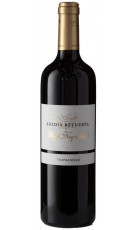
Vino de la Tierra de Castilla y León There are 138 products.
VT de Castilla y León
ORDEN AYG/296/2013, de 5 de abril, por la que se aprueba el Reglamento de la Indicación Geográfica Protegida «Vino de la Tierra de Castilla y León». Por O...
-
El Marciano 2022
Red wine.ALFREDO MAESTRO TEJEROVino de la Tierra de Castilla y LeónRed wine.
Reduced price! -
46 Cepas Merlot 2021
Red Wine.ALFREDO MAESTRO TEJEROVino de la Tierra de Castilla y LeónRed Wine
Reduced price! -
Prieto Pariente Viognier 2021
White WineBODEGAS PRIETO PARIENTEVino de la Tierra de Castilla y LeónWhite Wine, 5 months in oak barrels
In stock -
Abadía Retuerta Pago...
Red Wine CrianzaABADÍA RETUERTAVino de la Tierra de Castilla y LeónAbadía Retuerta Pago Negralada, a paid wine, the reflection of a terroir. It has developed its full potential after a dream of almost two years of aging in new French oak barrels. Its...
Reduced price!In stock -
Abadía Retuerta Pago...
Red Wine CrianzaABADÍA RETUERTAVino de la Tierra de Castilla y LeónRed Wine Crianza, 20 months in french oak barrels
Reduced price!In stock -
Viña Almate La Guindalera 2019
Red Wine.ALFREDO MAESTRO TEJEROVino de la Tierra de Castilla y LeónRed wine.
Reduced price!

VT de Castilla y León
ORDEN AYG/296/2013, de 5 de abril, por la que se aprueba el Reglamento de la Indicación Geográfica Protegida «Vino de la Tierra de Castilla y León». Por Orden de 15 de junio de 2000, de la Consejería de Agricultura y Ganadería («B.O.C. y L.» n.º 126, de 30 de junio), se reguló por primera vez el uso de la indicación geográfica «Vino de la Tierra de Castilla y León». Posteriormente, esta disposición sería derogada por la Orden de 10 de septiembre de 2002, de la Consejería de Agricultura y Ganadería («B.O.C. y L.» n.º 185, de 24 de septiembre), esta a su vez por la Orden AYG/323/2005, de 7 de marzo («B.O.C. y L.» n.º 51, de 15 de marzo) y, finalmente esta última, por la Orden AYG/57/2007, de 17 de enero («B.O.C. y L.» n.º 17, de 24 de enero), por la que se aprueba del Reglamento del «Vino de la Tierra de Castilla y León», actualmente en vigor. La Ley 24/2003, de 10 de julio, de la Viña y del Vino («B.O.E.» núm. 165, de 11 de julio), regula en su Título II el sistema de protección del origen y la calidad de los vinos, en concreto, en el artículo 19, los vinos con derecho a la mención tradicional «vino de la tierra».
Location
Castilla y León consists of a plateau with slight inclination East-West, surrounded by mountain systems: to the North, the Cantabrian mountains; to the Northeast, the Iberian; to the South, the Central and Northwest, the Montes de León.
Soils
Morphologically Castilla y León is a large basin filled by tertiary materials (conglomerates, clays, Sands and loams) Miocene. At certain points, they are protected by other materials more resistant to erosion, giving rise to the Moors, characteristic of the regional landscape. Moreover, there are rivers, which make up vegas and terraces and the outcrops of the socket Paleozoic in the western part of the Region. All of this ends up composing the morphological units of Castilla y León.
Climate
The predominant climate in Castilla y León is, therefore, continental semiarid Mediterranean-style, characterized by long, cold winters and short, warm and dry summers with a regime of scarce and unevenly distributed rainfall throughout the year, as well as for the extensive period of frost, with frequent late frosts and marked temperature fluctuations between summer and winter, and between day and night.
Vineyards
Growing conditions will be those that tend to get the best qualities of grape. They will be so they express the best balance between vegetation and the quality of the production.
Grapes
Whites: Albillo Mayor, Albillo Real, Viura (sin. Macabeo) y Verdejo. Authorized: Rojal (sin.: Malvasía Riojana, Alarije), Albarín Blanco, Albariño, Chardonnay, Malvasía Castellana (sin. Doña Blanca), Gewürztraminer, Godello, Montúa (sin. Chelva), Moscatel de Alejandría, Moscatel de grano menudo, Hondarrabi Zuri, Palomino, Riesling, Sauvignon Blanc, Treixadura y Viognier.
Reds: Garnacha Tinta, Juan García (sin. Mouraton), Mencía, Prieto Picudo y Tempranillo (sin.: Tinto Fino, Tinta del País, Tinta de Toro). Authorized: Bruñal (sin. Albarín Tinto), Cabernet Sauvignon, Garnacha Roja (sin. Garnacha Gris), Garnacha Tintorera, Graciano, Malbec, Merenzao, Merlot, Hondarrabi Beltza, Petit Verdot, Pinot Noir, Rufete y Syrah.
Production 2012
The maximum yields allowed for the production of the wines protected by the protected geographical indication «Came from the land of CASTILLA Y LEÓN» will be 16,000 kg of grapes per hectare of area, both for white varieties to red varieties, more than 120 hectolitres of wine per hectare may not be obtained.
Wines
The wines protected by the protected geographical indication «Came from the land of CASTILLA Y LEÓN» belong to category 1 "wine", 3 "liqueur wine" category, the category 5 "quality sparkling wine", category 8 "semi-sparkling wine" and 16 "wine of overripe grapes" category in accordance with annex XI ter of Regulation (EC) No 1234 / 2007.

(+34) 91 129 11 11
(+34) 638 458 218
- Brandy
- Cognac
- Gin Premium
- Ron
- Whisky
- Denomination of Origin
- Winery























